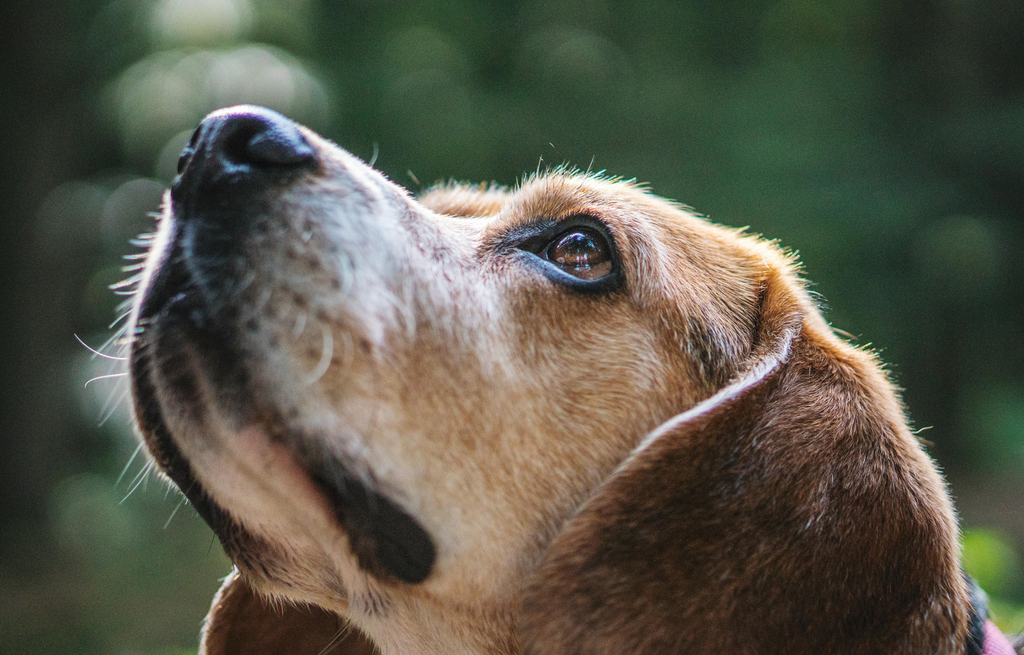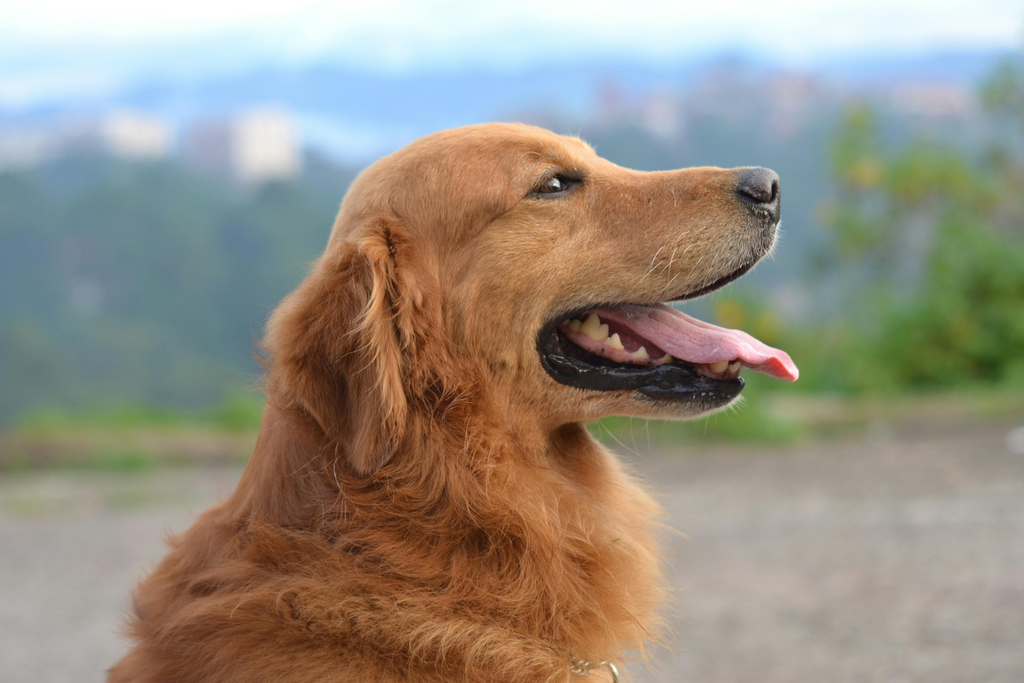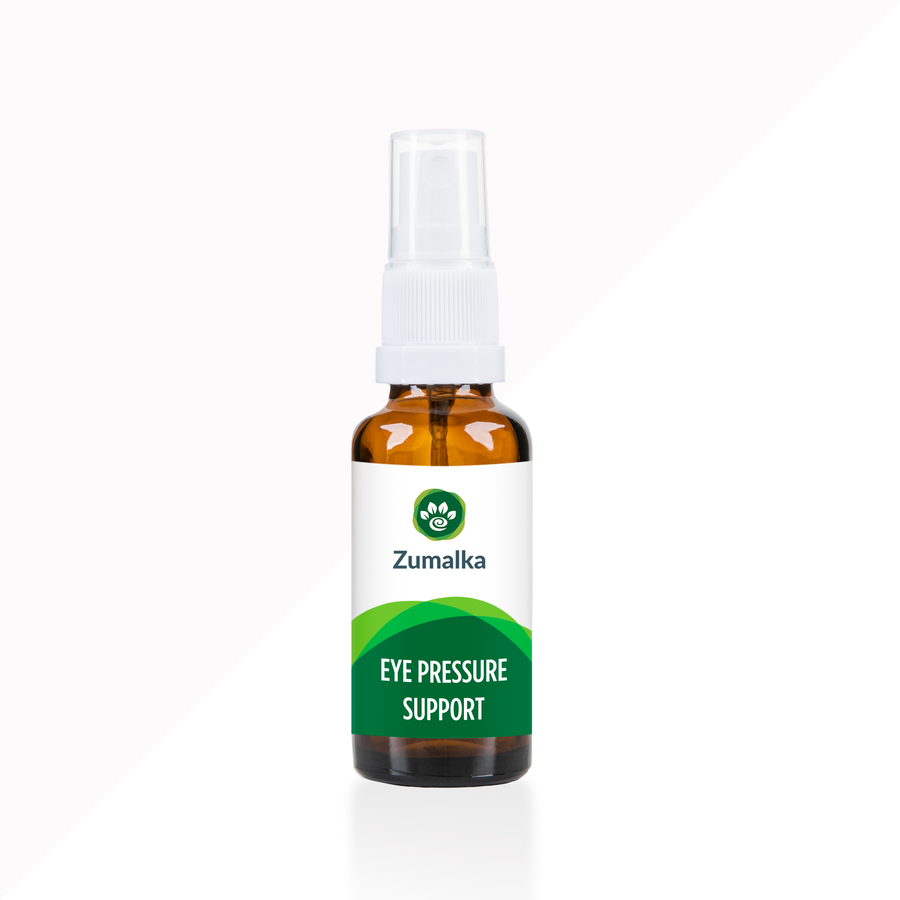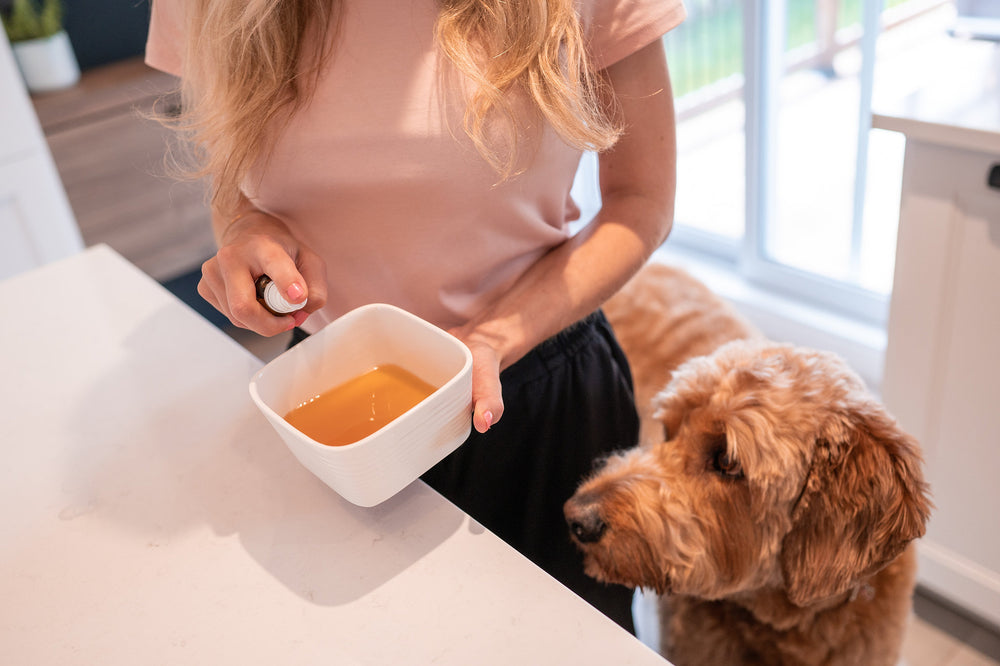Glaucoma in Dogs: Natural Home Remedies
Canine glaucoma is an eye disease that can significantly affect your dog's vision negatively. Regardless if it's acute glaucoma or chronic glaucoma, there is the possibility that the affected eye could become permanently blind.
We've put together this blog post to walk you through everything you need to know about glaucoma in dogs. Besides helping you become familiar with the clinical signs to keep an eye on, we will also give the possible causes and risk factors of dog glaucoma as well as the treatment options you can go for.
How about we kick things off by having a quick overview of what dog glaucoma is?
What is Glaucoma in Dogs?
Dog glaucoma takes place when there is high intraocular pressure (IOP) within the eye due to insufficient drainage of a substance called aqueous humor or aqueous fluid. It is called "intraocular pressure" since it is used to gauge the amount of force exerted inside the eye, particularly on the optic nerve.
Unlike what a lot of people mistakenly think, glaucoma does not pertain to excessive aqueous humor or aqueous fluid production. This eye disease refers to the lack of outflow of this fluid, which can eventually lead to increased intraocular pressure on the retina or optic nerve.
The optic nerve—also referred to as the optical nerve—is basically in charge of transporting visual information from the retina to the brain. Its overall function of carrying nerve signals can be disrupted by increased intraocular pressure, not to mention the possibility of ruptured lenses and even partial or complete vision loss in severe cases.
An instrument called a "tonometer" is utilized in veterinary ophthalmology to measure pressure inside the eye. Besides determining if there is too much fluid buildup or inadequate drainage, this instrument also checks if the dog being checked is already at risk of glaucoma.
This is the reason why consulting with a pet wellness expert or a veterinarian immediately is a must should you notice the clinical signs of glaucoma.
Glaucoma in Dogs is a Serious Problem

We'd just like to emphasize as early as now that the presence of intraocular pressure within the eye is pretty much normal. The risk of glaucoma just sets in when this pressure reaches excessively high levels.
It doesn't mean that there is excess fluid in the aqueous humor that this eye health problem is already present. So long as there is a proper outflow of the same, steps to decrease fluid production will not be necessary.
According to veterinary medicine guidelines, normal IOP in dogs ranges between 10 to 25 millimeters of mercury (mmHg). While these values may alternate from low to high intraocular pressure and vice versa, there is no risk of glaucoma in canines if your pet's IOP does not go over 40 mmHg.
However, immediate medical treatment is crucial should there be an irregularity in the drainage angle to manage the fluid inside the eye. This is usually fixed via surgical treatment options performed by a veterinary ophthalmologist.
We will discuss this more in detail in a separate part of the discussion, including how primary glaucoma sets in as well as how secondary glaucoma occurs. We'll also cover more natural resources to help support your pet and treat glaucoma during this health issue as we go along.
Is There a Difference Between Primary or Secondary Glaucoma?
Glaucoma is more frequently encountered in dogs (0.675%), although it’s possible in cats too (0.197%). But the thing is there are two types of glaucoma in canines that you should take note of: primary glaucoma and secondary glaucoma.
Primary glaucoma
At its simplest, primary glaucoma is characterized as glaucoma that was not set off by any other cause, such as an underlying disease. This is often linked with primary closed-angle glaucoma that typically affects the anterior chamber of the eye.
Dog breeds susceptible to this problem include Dalmatians, Golden Retrievers, Siberian Huskies, Poodles, Great Danes, and Cocker Spaniels, among others. Additionally, dogs diagnosed with this type are often purebred.
Secondary glaucoma
Compared to its primary counterpart, secondary glaucoma results when a dog is suffering from health issues like diabetes, eye inflammation, intraocular bleeding, as well as severe intraocular infections. This can also possibly stem from the use of steroids and the presence of scar tissue that disrupts the drainage angle of the eye's anterior chamber.
It is important to remember, though, that whether it is primary or secondary glaucoma, proper and immediate treatment is required since both can eventually lead to acute glaucoma or chronic glaucoma that will take a toll on a dog's optic nerve.
Glaucoma vs. cataracts in dogs
Glaucoma is not the same as canine cataracts. Although both conditions affect the eyes, cataracts refer to a partial or total opacity of the lens. It can be identified by a white or bluish tint in the center of your dog's eye. Moreover, an advanced cataract can cause the development of glaucoma.
What Causes Glaucoma in Dogs?

Heredity, cataracts, inflammation in the eyes or a tumor in the eye are possible causes of glaucoma in dogs. Additionally, some dogs will be unlucky in the genetic lottery and develop glaucoma simply because of genes passed down from their parents.
As mentioned previously, elevated intraocular pressure can be induced by cataracts. Glaucoma can develop when the lens undergoes an anterior dislocation, which interferes with the drainage angle of the aqueous humor.
Inflammation in the eyes can also induce glaucoma. This inflammation, either secondary to an infection or uveitis, for example, can interfere with the drainage of intraocular fluid and lead to increased pressure in the eye.
Finally, if your dog develops a tumor in or near the eye, it may lead to the developing glaucoma of the secondary type. This tumor can put physical pressure on the eyeball and increase intraocular pressure. The tumor can also directly interfere with the drainage of the aqueous humor.
Intraocular pressure within the eye during primary or secondary glaucoma
As we've discussed earlier, intraocular pressure, or IOP pertains to the force that is exerted within the eye. It is not something to worry about so long as it's within the normal range. However, in the case of acute glaucoma or chronic glaucoma, the IOP tends to go beyond 40 mmHg, which can already be harmful to the optic nerve.
Signs of Glaucoma in Dogs
Symptoms of glaucoma in dogs can vary from one animal to another. It can also be different in cases of acute glaucoma. Glaucoma can be identified by a half-closed, uncomfortable eye, or by an enlarged eye in more advanced cases.
However, it is rather rare for glaucoma to be in both of your dog's eyes at the same time. The signs vary depending on the stage of the disease.
Early stage indicators
In the early stages of the disease, symptoms can be very subtle and often go unnoticed. Glaucoma occurs in most dogs when the following indicators come in the picture:
-
Bloodshot eye
-
Eye pain
-
Watery discharge
-
Irregularity in the ciliary body
-
Half-closed or closed-eye
-
The white-bluish appearance of the cornea
-
Dilated pupil
-
Redness of the eye
-
Increased frequency of blinking
-
Corneal edema
-
Tearing
Late/end stage indicators
The more the disease progresses, the more severe the signs of glaucoma become:
-
Prominent swelling of the eye
-
Disrupted function of the ciliary body
-
Diffuse corneal edema
-
Loss of vision
-
Lethargy, loss of appetite (secondary to significant pain)
-
Possible presence of a blood clot in and around the affected eye
How Do You Treat Glaucoma?

Several approaches exist for the treatment of glaucoma in dogs. Your vet will talk to you about conventional medical treatment, while a holistic vet can talk to you about natural options for relieving it.
Conventional treatment
If your dog has this eye health problem, your vet will suggest different treatments such as medical eye drops or ointments to try to reduce the pressure in the eye. In more advanced cases, surgery (like laser surgery) may be recommended.
Surgery in a veterinary setting is always relatively expensive, but it is sometimes essential for the comfort of the animal. Since surgeries to relieve glaucoma are often more complex and performed by veterinarians who specialize in ophthalmology, the cost can easily run into the thousands of dollars.
Disadvantages of conventional treatments
Options like topical carbonic anhydrase inhibitors and the use of anterior chamber shunts tend to provide therapeutic effects almost immediately. Products like Mannitol significantly reduce IOP in less than twenty (20) minutes, giving relief to the ciliary body and its fluid-producing cells.
But the problem is aside from being invasive, you cannot also give certain conventional treatment options to dogs that have cardiovascular disease or some other underlying condition. While these conventional recourses may have a multicenter clinical trial, they can still trigger some adverse side effects.
Is There a Way to Prevent This Eye Disease?
Your vet will likely suggest diagnostic tests to find out the cause of your dog's glaucoma. In cases of glaucoma that is secondary to a disease, they may suggest that you use preventive medication on the unaffected eye since an underlying cause predisposes both eyes to the development of glaucoma.
With that said, a gentle and natural way to prevent glaucoma in dogs is to ensure that you always provide a good balanced diet to your pet and ensure that it receives all the nutrients and vitamins necessary for proper eye functioning.
Boosting your dog's overall immune system health as early as now is also an effective way to keep this health problem at bay.
Home Remedies That You Can Use
If you prefer a gentler approach, here are our tips for natural treatments for canine glaucoma. We suggest spinach, carrots, vitamin C, magnesium, and CBD oil. Of course, getting your vet’s advice is always recommended to confirm that these natural solutions are appropriate for your doggie.
Spinach
Spinach does not only give strength to the well-known Popeye! It contains a high level of carotenoids, which help to support and strengthen eye tissue. This helps prevent the degeneration of the eyes and is therefore an asset in cases of glaucoma! Adding chunks of fresh spinach to your dog's meal is a great way to incorporate it into your dog's diet.
Carrots
Similarly, carrots contain a type of carotenoid that is valuable for eye health; beta-carotene. This is probably why children are told to eat carrots to have good vision! Beta-carotene is a precursor to vitamin A and plays an important role in maintaining the integrity of cells in the eyes.
Vitamin C
Vitamin C helps control the presence of free radicals in the body and thus helps reduce inflammation. This is why vitamin C can be an ally in cases of glaucoma. Dogs synthesize vitamin C naturally in their bodies, but a deficiency in this vitamin can lead to health consequences. Adding a vitamin C supplement to your dog's diet should, however, be evaluated by your vet to ensure that it does not cause an imbalance in the body.
Magnesium
Magnesium can help relieve your dog's glaucoma since it works on blood circulation by relaxing the walls of blood vessels. As glaucoma is manifested by an increase in pressure in the eye, magnesium can have an impact on this disease due to this characteristic.
CBD oil
The use of CBD oil is increasingly popular, both in humans and animals, for pain control among other things. While it doesn’t treat glaucoma directly, this product could help relieve the discomfort caused by this condition.
Be careful, some CBD oils sold on the market may contain traces of THC (toxic for dogs)! It is therefore necessary to ensure that the product you buy is safe for animals.
A Natural Product You Should Consider
Zumalka's Eye Pressure Support is primarily designed to maintain normal eye pressure and better overall eye health. This natural option also helps reduce marked pressure buildup and is aimed at fortifying and nourishing the eye to preserve as much of your pet’s vision as possible in a non-intrusive way!
If you're looking for an option that is friendlier to your dog (and won't lead to adverse side effects sooner or later), getting your hands on EYE PRESSURE SUPPORT is one alternative you should check out.







Hi Sheree, Actually yes we do have our CLEARVISION remedy which is specifically to help slow/stop the progression of cataracts. Have a look!
-ZUMALKA
I have a 8 year old Chihuahua that is showing signs of early cataracts. He is healthy in every other day. So I am wondering if you carry any type of supplement that would slow the cataracts down.
Hi Barbara,
Thank you for leaving us your comment and I hope that this article has had some good tips for your dog’s glaucoma.
We are also going to send you an email so that we can get all the details on your dog’s health so that we can offer the best natural and personalized recommendations.
We look forward to working together to help your dog!
-Zumalka
My dog is only 6 yrs old and has been diagnosed with glocoma. I am on a fixed income and can’t afford meds or surgery. Is there anywhere I can get help? Already trued humane society, couldn’t help. Thank you in advance Barb Bryant
Leave a comment